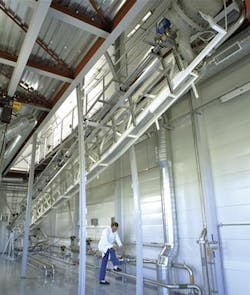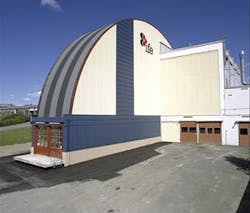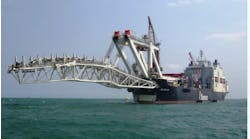The Institute for Energy Technology (IFE) is hoping soon to kick off a research program called Horizon, which focuses on the long-distance transport of multiphase wellstreams. The program will extend the capability of the Olga transient multiphase flow simulator to model long-distance flows. It will be carried out with IFE's partner Scandpower, which is responsible for marketing Olga. In March, IFE was in talks with potential oil company sponsors for the NKr45-million, three-year program.
Horizon involves the further development of Olga to meet perceived industry needs, according to Dag Thomassen, department head for process and fluid flow technology. Long-distance multiphase transport is on the agenda for oil and gas companies, though it is not a new topic for the institute. It has worked on Statoil's Snøhvit development on and off for 10 years, contributing to the licensees' decision to install a 160-km multiphase tie-back to shore, the longest yet planned in the world.
But when last year IFE carried out work on a challenging field development coming up off Norway involving a long-distance multiphase tie-back to shore, it became clear that it was difficult for Olga in its present state to accommodate some new experimental data. The same applies to other data that has become available, both in the literature and from experimental work carried out at IFE.
null
Horizon aims to develop the tool's ability accurately to model long-distance flows of both gas-condensate and oil streams. It will also address related problems faced on mature fields where production is moving into the tail-end phase.
The program is divided into four projects:
- Basic multiphase flow models
- Flow assurance related activities
- Well technology
- Integrated systems and work processes.
Improved accuracy
The first project will deal with the need for improved accuracy in the flow models. At present there are still uncertainties in predictions, and these can open the way to serious operational problems, Thomassen says. When, for example, the flow rate is reduced, liquids accumulate in the pipeline, reducing the ability of the gas to lift it. At some point that is currently difficult to predict accurately, a big liquid hold-up will occur that may cause operational limitations.
Another area of uncertainty to be investigated is how the liquid divides into conden-sate and water. Knowing that is important for predicting hydrate formation and the occurrence of corrosion. A more accurate prediction of where the water is located is also important.
The project on flow assurance will develop new modules for slurry transport, hydrates, wax, and sand. The institute is already involved in work on some of these areas. Early last year it completed a joint industry project with the Institut Français du Petrole on slurry transport using the high-pressure loop at IFP's Solaize facility. It is now organizing a new JIP for modeling the two-phase flow of oil and hydrate slurry. It is also completing a JIP with Sintef on sand transport.
The project on well technology relates to tail-end production. As fields age, the wells tend to become unstable. The use of gas-lift, which is often seen as the solution to improving production in aging wells, can aggravate instability by making the fluid behavior downhole more dynamic. To throw light on why this happens, a near-well zone model will be developed and coupled to Olga.
At present, Olga's ability to predict what happens downhole is limited as it uses only simple inflow models. The project will investigate the hypothesis that the flow in the near-well zone interacts negatively with the well-bore flow, which in turn leads to positive feedback from the well, and that this is the cause of the instability.
The project on integrated systems and work processes will tackle challenges such as simulating the interaction between sub-systems in the production process. Often, different disciplines are involved in designing the well, the transport line, and the process system, which means that errors can arise at the interfaces. There is a need for improved work processes and cooperation, for a better flow of knowledge between them, and for the different formats in use to be harmonized.
Making OLGA more accurate and reliable is important, as the safety margins get tighter as pipelines get longer, Thomassen says. On the other hand, being able to work confidently with smaller safety margins is necessary to achieve an optimal design. The Horizon project should contribute to reducing conservatism in the design as well as improving the operation of multiphase pipelines.





